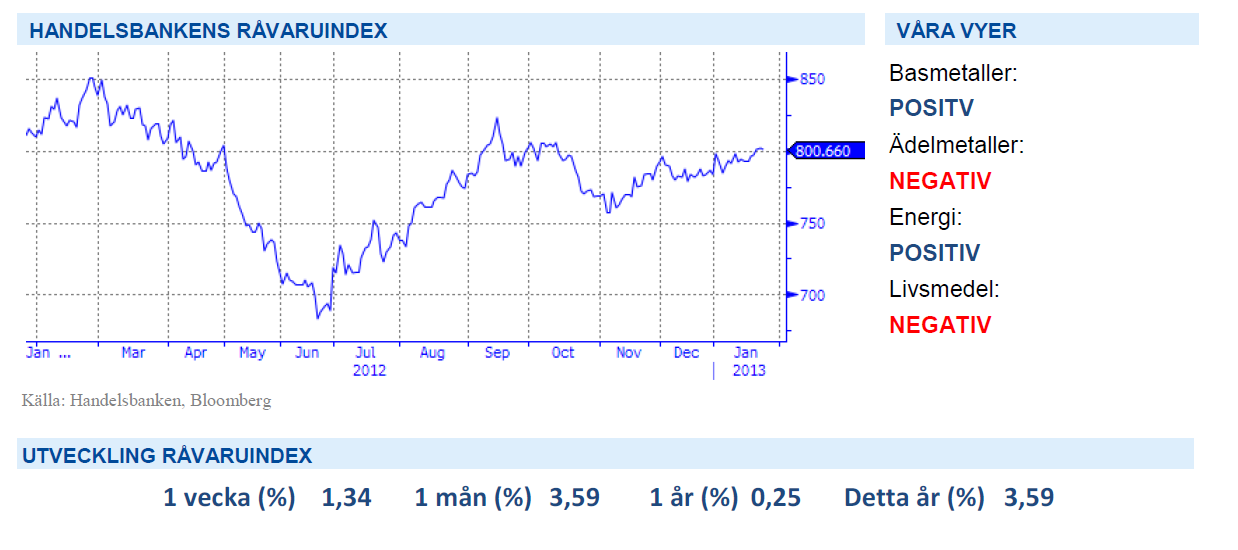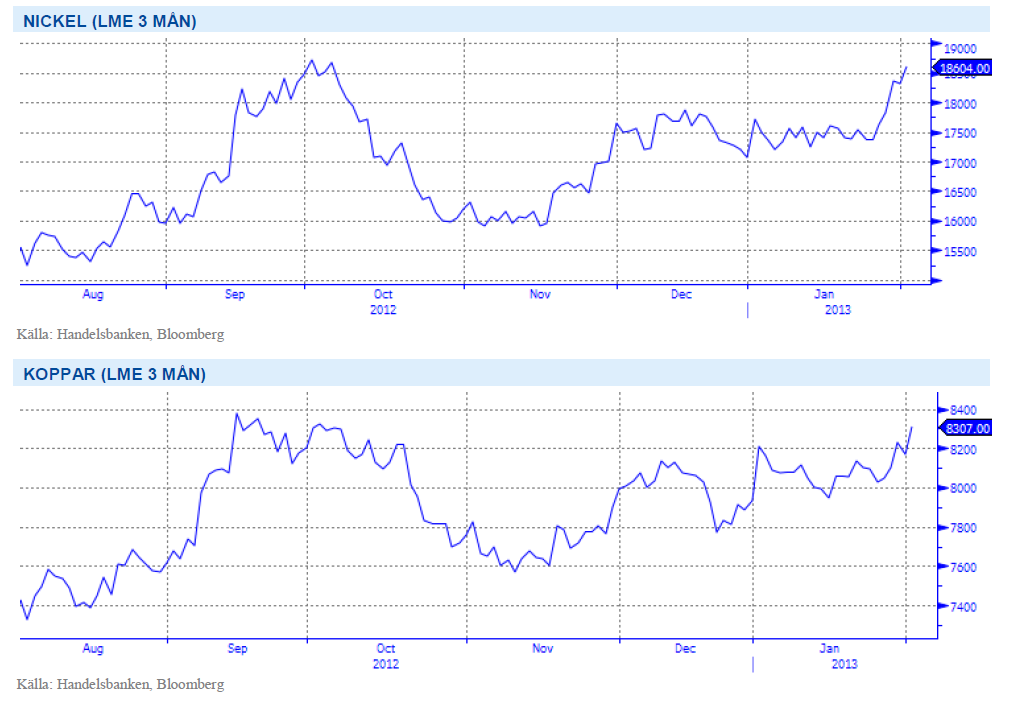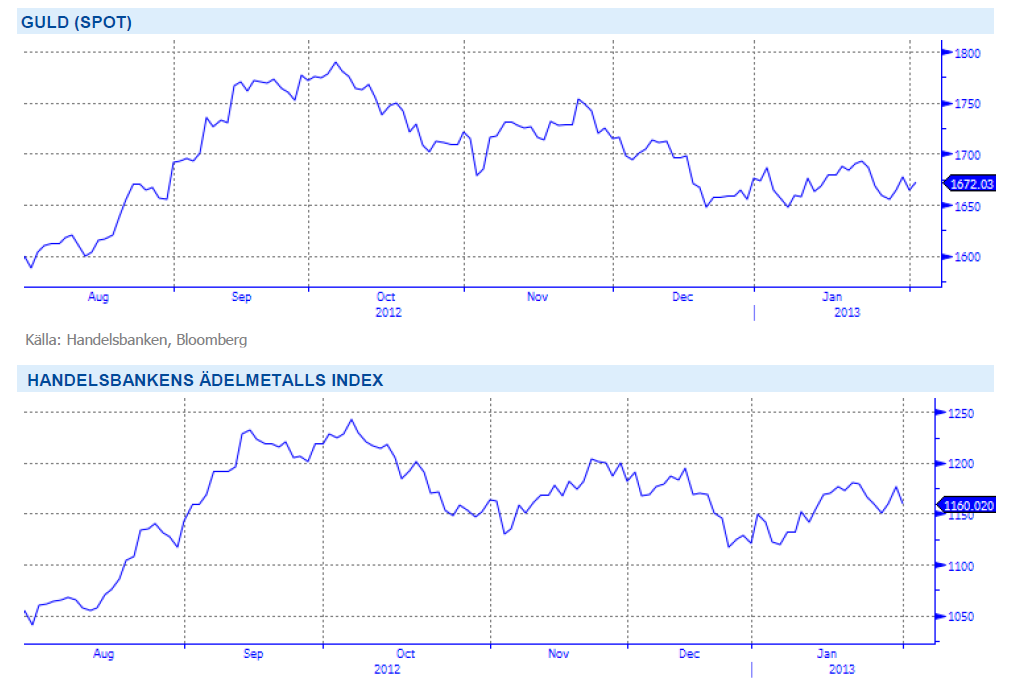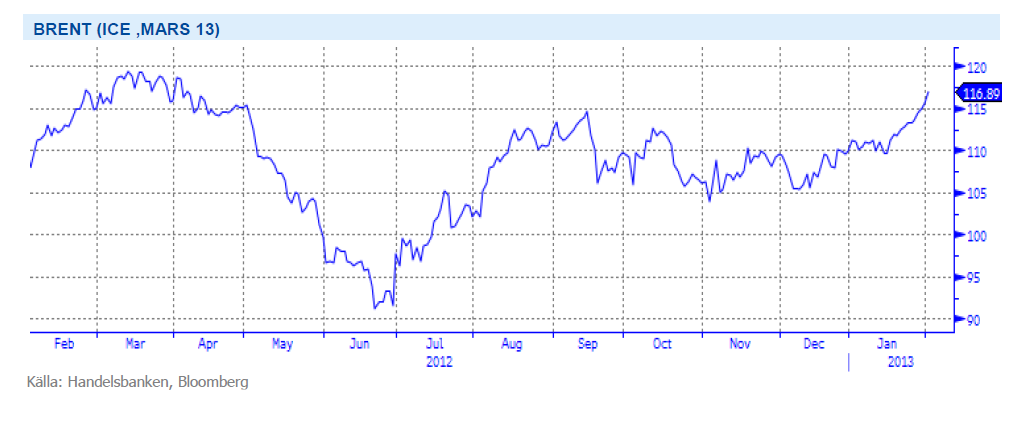Analys
SHB Råvarubrevet 1 februari 2013

 Råvaror Allmänt
Råvaror Allmänt
Risk On för råvaror
Årets starka inledning för aktiemarknader har nu börjat smitta av sig på råvaror. Under veckan har råvaror äntligen fått sitt genombrott och de konjunkturhandlade råvarorna basmetaller och olja klättrat så gott som varje dag. USA:s BNP för Q4 kom in svagare än väntat under onsdagen och fick guld att hoppa upp i tron att det förlänger penningpolitiska stimulanser i USA. Annars har guld fallit i takt med att investerare viktar om från defensiva positioner som guld till mer offensiva, konjunkturberoende positioner. Denna trend tror vi fortsätter och vi sänker därför Ädelmetaller till negativ och växlar upp Energi från neutral till positiv.
Under veckan fick vi också mer vatten på vår kvarn för fortsatt penningpolitisk stimulans i USA, den enskilt viktigaste faktorn för att hålla det positiva sentimentet uppe i världsekonomin just nu. Chefen för amerikanska centralbanken, Fed Ben Bernanke, signalerade att Fed inte är nära att minska stödköpen som sker för att stimulera ekonomin och minska arbetslösheten.
Basmetallerna
Ökad riskaptit gynnar basmetallerna
Basmetallerna lägger en vecka bakom sig med stigande priser, med uppgångar på 2-3 procent. Den metall som sticker ut är nickel som stigit med 6,6 % under veckan, den största ökningen på en vecka sedan november. På året har metallen stigit med hela 8,5 % och det främst ekonomisk data från Kina och USA som driver på uppgången.
Senaste veckan har koppar nått 3-månaders högsta som en följd av nyheter på snabbare ekonomisk tillväxt och vinsthemtagningar för kinesiska industribolag. Jobbsiffror som inte mötte förväntningar höll dock tillbaka uppgången något under fredagen. Kinas återhämtning från konjunkturnedgången går långsamt med säkert. De viktigaste indikatorerna pekar uppåt och BNP för Q4 såg för första gången på 10 kvartal bra ut. Den råvarusektor som är mest beroende av kinas återhämtning är basmetaller och till dessa är vi fortsatt positiva.
Den globala tillväxten har fått ny kraft och gynnar konjunkturkänsliga råvaror som basmetaller. Vi tror på: BASMET H
Ädelmetaller
Vi byter fot på guldet!
Efter att ha haft en positiv syn på ädelmetaller ända sedan Fed-chefens tal i Jackson Hole i slutet av augusti börjar vi nu bli betydligt mer tveksamma. Efter Jackson Hole har guldet som högst handlat drygt 8 procent upp, men har sedan toppen i början av oktober glidit lugnt men säkert nedåt. Under 2013 har guldet handlat mellan 1650 och 1700 dollar per uns, vilket är exakt samma nivåer som rådde i augusti.
Vår positiva syn sedan dess har byggt på två hörnstenar, nämligen den extrema stimulans som centralbanker världen över ägnar sig åt, och de stigande inflationsförväntningar som kommer med detta. Årets starka inledning på världens aktiemarknader, och de positiva konjunktursignaler vi fått, och det något minskade fokus som rått på euro-krisen gör att vi tror att det positiva risksentimentet fortsätter. Potentiellt stigande räntenivåer, fortsatt riskaptit kombinerat med utebliven prisuppgång på guldet får oss att tro att nästa stora rörelse kommer att vara nedåt.
Som alltid är timing på sådant här väldigt svårt, men en budgetuppgörelse i USA under februari tror vi kan vara en trigger för en större rörelse på nedsidan. Guldet befinner sig fortfarande på väldigt höga nivåer i ett historiskt perspektiv, varför vi känner oss bekväma att skifta vy 180 grader i detta läge.
Med fortsatt positivt risksentiment och potentiellt stigande räntenivåer ser vi nästa stora rörelse kommer att vara nedåt. Vi tror på GULD S H
Energi
Ökad riskaptit gynnar även oljan
Brent-oljan har handlats i en uppåtgående trend i över 2 veckor och handlas nu över 117-nivån, en nivå vi inte sett sedan mitten av april. Torsdagens löfte från amerikanska centralbanken att fortsätta sina obligationsköp samt positiv makrodata från euroområdet ger ökad riskaptit vilket gynnar oljan. Oljemarknaden stabiliseras av att Saudi nu sänker produktionen för att stabilisera priset. Den säsongsmässigt starka delen av året ligger också framför oss när det gäller oljekonsumtion. Utsläppsrätterna avslutar veckan i princip oförändrad efter kraftig uppgång under fredagen. Det var efter Angela Merkels uttalande att hon stödjer backloadingplanen (en plan för att minska överskott av rätter, ca 30 % till 2015) som priset snabbt steg 30 % och därmed raderade veckans tidigare nedgång.
Som vi tidigare skrivit är det svårt att se hur EU Kommissionen skall agera kring tilldelning och balans för att undvika att förtroendet för marknaden urholkas helt för all framtid. Vidare det mer grundläggande problemet kring svårigheten att få till ett globalt direktiv där man involverar USA och tillväxtmarknaderna vilket är det enda som ger stöd och mening åt den europeiska marknaden. Elmarknaden handlas i stort sett oförändrat över veckan. Då kontinentala elpriser och det tyska i synnerhet är lågt bör det finnas utrymme för nordisk att falla något till från dagens nivå om 35 euro. Vi förväntar oss dock inga större rörelser utan att det mesta diskonterats för varför vi ändrat vår syn från kort till neutral. Inte omöjligt att vi kanske t.o.m får se en liten tillfällig uppgång om det kalla och torra vädret som givit stöd denna vecka består vilket påverkar en redan försvagad energibalans. Prognoserna visar idag att vi får en normal utveckling på slutet av tio dagars perioden.
Den råvarugrupp som är mest beroende av den globala konjunkturen är Energi och med en starkare konjunktur ser vi positivt på utvecklingen för denna sektor. Vi tror på: ENERGI H
Livsmedel
Försämrat skick på det amerikanska vetet
Priset på vete är svagt upp denna vecka. Än är det torrt och varmt för det amerikanska höstvetet, vilket gör att skicket på grödan fortsätter att försämras. I december månad var låga 25 procent av höstvetet i delstaten Kansas i skicket good/excellent, idag uppskattas samma siffra till rekordlåga 20 procent – vid samma tid förra året var motsvarande siffra mer normala 45 procent. Torrt väder väntas även nästa vecka och det kommer verkligen behövas en gynnsam vår för att grödorna ska återhämta sig någorlunda.
I EU bedöms allt fortfarande vara helt ok, generellt sett bra med snö och varmare temperaturer. I en del områden har snön regnat bort men temperaturen är relativt hög och ser ut att förbli så framöver. I Ukraina steg temperaturen något i slutet av veckan men än finns det generellt sett gott om skyddande snö kvar om kylan återvänder. I Ryssland uppges allt vara ok, beräknad utvintring ligger omkring 10 procent vilket är ganska normalt. Kanadas totala veteareal väntas nå 25,3 miljoner acres, upp från förra årets 23,8 miljoner acres. Höstvetet i USA är alltså i riktigt dåligt skick och någon klar förbättring är inte i sikte. I andra veteregioner i världen råder dock inga större problem vilket håller tillbaka en prisuppgång. Än finns det dessutom tid för regn att falla inför sådd av majs i USA – vilket spannmålsmarknaden kommer lägga stort fokus på under kommande veckor. Givet inga större väderproblem bör vi dock vänta oss fallande priser lite längre fram på året.
Vi ser fortfarande framför oss fallande priser på livsmedelsektor på lite längre sikt. Vi tror på: LIVSMEDEL S H
Handelsbankens Råvaruindex
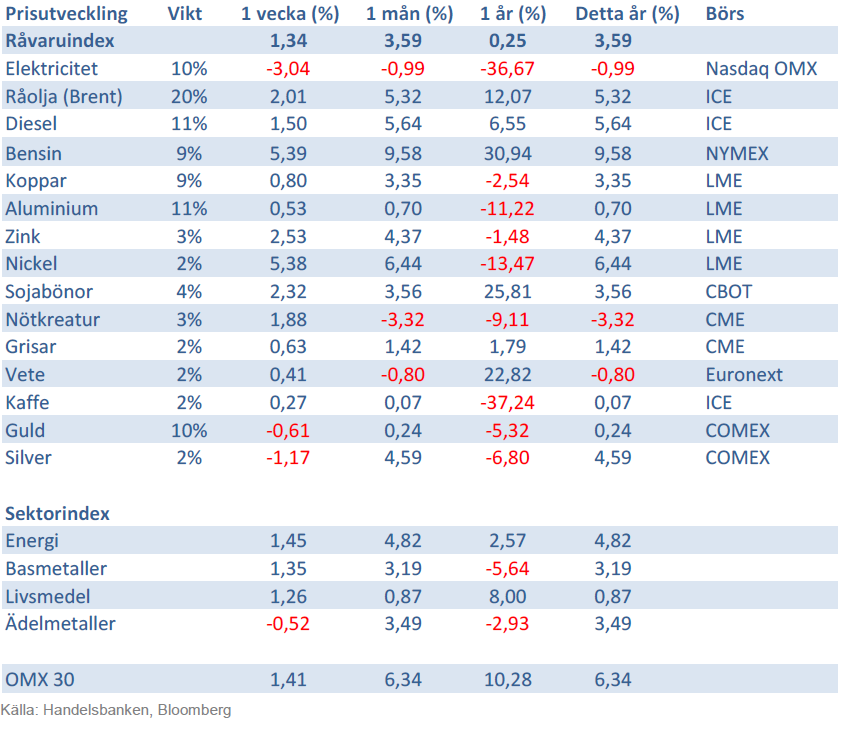
Handelsbankens råvaruindex består av de underliggande indexen för respektive råvara. Vikterna är bestämda till hälften från värdet av global produktion och till hälften från likviditeten i terminskontrakten.
[box]SHB Råvarubrevet är producerat av Handelsbanken och publiceras i samarbete och med tillstånd på Råvarumarknaden.se[/box]
Ansvarsbegränsning
Detta material är producerat av Svenska Handelsbanken AB (publ) i fortsättningen kallad Handelsbanken. De som arbetar med innehållet är inte analytiker och materialet är inte oberoende investeringsanalys. Innehållet är uteslutande avsett för kunder i Sverige. Syftet är att ge en allmän information till Handelsbankens kunder och utgör inte ett personligt investeringsråd eller en personlig rekommendation. Informationen ska inte ensamt utgöra underlag för investeringsbeslut. Kunder bör inhämta råd från sina rådgivare och basera sina investeringsbeslut utifrån egen erfarenhet.
Informationen i materialet kan ändras och också avvika från de åsikter som uttrycks i oberoende investeringsanalyser från Handelsbanken. Informationen grundar sig på allmänt tillgänglig information och är hämtad från källor som bedöms som tillförlitliga, men riktigheten kan inte garanteras och informationen kan vara ofullständig eller nedkortad. Ingen del av förslaget får reproduceras eller distribueras till någon annan person utan att Handelsbanken dessförinnan lämnat sitt skriftliga medgivande. Handelsbanken ansvarar inte för att materialet används på ett sätt som strider mot förbudet mot vidarebefordran eller offentliggörs i strid med bankens regler.
Analys
Tightening fundamentals – bullish inventories from DOE

The latest weekly report from the US DOE showed a substantial drawdown across key petroleum categories, adding more upside potential to the fundamental picture.

Commercial crude inventories (excl. SPR) fell by 5.8 million barrels, bringing total inventories down to 415.1 million barrels. Now sitting 11% below the five-year seasonal norm and placed in the lowest 2015-2022 range (see picture below).
Product inventories also tightened further last week. Gasoline inventories declined by 2.1 million barrels, with reductions seen in both finished gasoline and blending components. Current gasoline levels are about 3% below the five-year average for this time of year.
Among products, the most notable move came in diesel, where inventories dropped by almost 4.1 million barrels, deepening the deficit to around 20% below seasonal norms – continuing to underscore the persistent supply tightness in diesel markets.
The only area of inventory growth was in propane/propylene, which posted a significant 5.1-million-barrel build and now stands 9% above the five-year average.
Total commercial petroleum inventories (crude plus refined products) declined by 4.2 million barrels on the week, reinforcing the overall tightening of US crude and products.


Analys
Bombs to ”ceasefire” in hours – Brent below $70

A classic case of “buy the rumor, sell the news” played out in oil markets, as Brent crude has dropped sharply – down nearly USD 10 per barrel since yesterday evening – following Iran’s retaliatory strike on a U.S. air base in Qatar. The immediate reaction was: “That was it?” The strike followed a carefully calibrated, non-escalatory playbook, avoiding direct threats to energy infrastructure or disruption of shipping through the Strait of Hormuz – thus calming worst-case fears.

After Monday morning’s sharp spike to USD 81.4 per barrel, triggered by the U.S. bombing of Iranian nuclear facilities, oil prices drifted sideways in anticipation of a potential Iranian response. That response came with advance warning and caused limited physical damage. Early this morning, both the U.S. President and Iranian state media announced a ceasefire, effectively placing a lid on the immediate conflict risk – at least for now.
As a result, Brent crude has now fallen by a total of USD 12 from Monday’s peak, currently trading around USD 69 per barrel.
Looking beyond geopolitics, the market will now shift its focus to the upcoming OPEC+ meeting in early July. Saudi Arabia’s decision to increase output earlier this year – despite falling prices – has drawn renewed attention considering recent developments. Some suggest this was a response to U.S. pressure to offset potential Iranian supply losses.
However, consensus is that the move was driven more by internal OPEC+ dynamics. After years of curbing production to support prices, Riyadh had grown frustrated with quota-busting by several members (notably Kazakhstan). With Saudi Arabia cutting up to 2 million barrels per day – roughly 2% of global supply – returns were diminishing, and the risk of losing market share was rising. The production increase is widely seen as an effort to reassert leadership and restore discipline within the group.
That said, the FT recently stated that, the Saudis remain wary of past missteps. In 2018, Riyadh ramped up output at Trump’s request ahead of Iran sanctions, only to see prices collapse when the U.S. granted broad waivers – triggering oversupply. Officials have reportedly made it clear they don’t intend to repeat that mistake.
The recent visit by President Trump to Saudi Arabia, which included agreements on AI, defense, and nuclear cooperation, suggests a broader strategic alignment. This has fueled speculation about a quiet “pump-for-politics” deal behind recent production moves.
Looking ahead, oil prices have now retraced the entire rally sparked by the June 13 Israel–Iran escalation. This retreat provides more political and policy space for both the U.S. and Saudi Arabia. Specifically, it makes it easier for Riyadh to scale back its three recent production hikes of 411,000 barrels each, potentially returning to more moderate increases of 137,000 barrels for August and September.
In short: with no major loss of Iranian supply to the market, OPEC+ – led by Saudi Arabia – no longer needs to compensate for a disruption that hasn’t materialized, especially not to please the U.S. at the cost of its own market strategy. As the Saudis themselves have signaled, they are unlikely to repeat previous mistakes.
Conclusion: With Brent now in the high USD 60s, buying oil looks fundamentally justified. The geopolitical premium has deflated, but tensions between Israel and Iran remain unresolved – and the risk of missteps and renewed escalation still lingers. In fact, even this morning, reports have emerged of renewed missile fire despite the declared “truce.” The path forward may be calmer – but it is far from stable.
Analys
A muted price reaction. Market looks relaxed, but it is still on edge waiting for what Iran will do

Brent crossed the 80-line this morning but quickly fell back assigning limited probability for Iran choosing to close the Strait of Hormuz. Brent traded in a range of USD 70.56 – 79.04/b last week as the market fluctuated between ”Iran wants a deal” and ”US is about to attack Iran”. At the end of the week though, Donald Trump managed to convince markets (and probably also Iran) that he would make a decision within two weeks. I.e. no imminent attack. Previously when when he has talked about ”making a decision within two weeks” he has often ended up doing nothing in the end. The oil market relaxed as a result and the week ended at USD 77.01/b which is just USD 6/b above the year to date average of USD 71/b.

Brent jumped to USD 81.4/b this morning, the highest since mid-January, but then quickly fell back to a current price of USD 78.2/b which is only up 1.5% versus the close on Friday. As such the market is pricing a fairly low probability that Iran will actually close the Strait of Hormuz. Probably because it will hurt Iranian oil exports as well as the global oil market.
It was however all smoke and mirrors. Deception. The US attacked Iran on Saturday. The attack involved 125 warplanes, submarines and surface warships and 14 bunker buster bombs were dropped on Iranian nuclear sites including Fordow, Natanz and Isfahan. In response the Iranian Parliament voted in support of closing the Strait of Hormuz where some 17 mb of crude and products is transported to the global market every day plus significant volumes of LNG. This is however merely an advise to the Supreme leader Ayatollah Ali Khamenei and the Supreme National Security Council which sits with the final and actual decision.
No supply of oil is lost yet. It is about the risk of Iran closing the Strait of Hormuz or not. So far not a single drop of oil supply has been lost to the global market. The price at the moment is all about the assessed risk of loss of supply. Will Iran choose to choke of the Strait of Hormuz or not? That is the big question. It would be painful for US consumers, for Donald Trump’s voter base, for the global economy but also for Iran and its population which relies on oil exports and income from selling oil out of that Strait as well. As such it is not a no-brainer choice for Iran to close the Strait for oil exports. And looking at the il price this morning it is clear that the oil market doesn’t assign a very high probability of it happening. It is however probably well within the capability of Iran to close the Strait off with rockets, mines, air-drones and possibly sea-drones. Just look at how Ukraine has been able to control and damage the Russian Black Sea fleet.
What to do about the highly enriched uranium which has gone missing? While the US and Israel can celebrate their destruction of Iranian nuclear facilities they are also scratching their heads over what to do with the lost Iranian nuclear material. Iran had 408 kg of highly enriched uranium (IAEA). Almost weapons grade. Enough for some 10 nuclear warheads. It seems to have been transported out of Fordow before the attack this weekend.
The market is still on edge. USD 80-something/b seems sensible while we wait. The oil market reaction to this weekend’s events is very muted so far. The market is still on edge awaiting what Iran will do. Because Iran will do something. But what and when? An oil price of 80-something seems like a sensible level until something do happen.
-

 Nyheter3 veckor sedan
Nyheter3 veckor sedanMahvie Minerals växlar spår – satsar fullt ut på guld
-

 Nyheter4 veckor sedan
Nyheter4 veckor sedanUppgången i oljepriset planade ut under helgen
-

 Nyheter4 veckor sedan
Nyheter4 veckor sedanLåga elpriser i sommar – men mellersta Sverige får en ökning
-

 Nyheter3 veckor sedan
Nyheter3 veckor sedanJonas Lindvall är tillbaka med ett nytt oljebolag, Perthro, som ska börsnoteras
-

 Analys3 veckor sedan
Analys3 veckor sedanA muted price reaction. Market looks relaxed, but it is still on edge waiting for what Iran will do
-

 Nyheter3 veckor sedan
Nyheter3 veckor sedanOljan, guldet och marknadens oroande tystnad
-

 Analys4 veckor sedan
Analys4 veckor sedanVery relaxed at USD 75/b. Risk barometer will likely fluctuate to higher levels with Brent into the 80ies or higher coming 2-3 weeks
-

 Nyheter3 veckor sedan
Nyheter3 veckor sedanDomstolen ger klartecken till Lappland Guldprospektering


